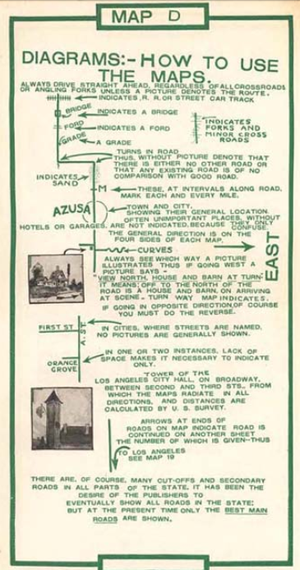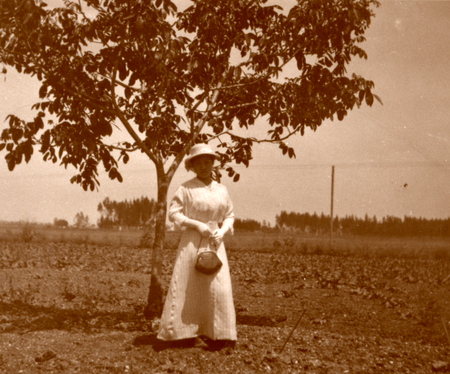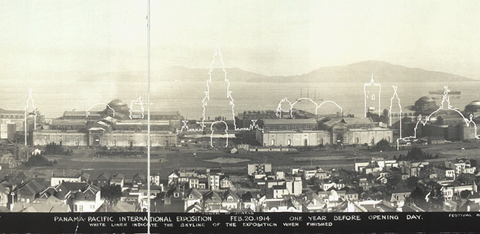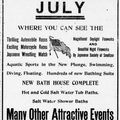Read Part 1 >>
The dawn of a new year, unrest and change
A tremendous social shift was occurring as the world marched toward globalization. In Europe, 1914 would bring the beginning of World War I with the outbreak of conflict and declarations of war. Some from Wintersburg Village and Huntington Beach would later leave the peatlands for military service. Japan would join the allies and later declare war on Germany, invading their settlement in China.
In South Africa in 1914, Mahatma Gandhi would be arrested campaigning for Indian rights. In Latin America, the Panama Canal opened, providing easier steamship travel between the Pacific and Atlantic, and creating excitement in California ports about the "Panama ditch."

The Hamilton Illustrated Auto Road Map for California in 1914 included an explanation about how to read the map. The maps included pictures of landmarks, like barns and trees, to help drivers find their way. As noted on the description at right, "unimportant places without hotels or garages, are not indicated because they only confuse."
U.S. Marines were sent to Mexico by President Woodrow Wilson after an attack on Americans at the port of Tampico, and America occupied Veracruz. The California National Guard and naval militia were sent to the border. Mexico ended diplomatic relations with the United States.
In Wintersburg, the events in Mexico meant the welcome arrival of the Escalante Brothers Circus. Traveling north by oxen cart to escape the fighting, the troop hoisted their tents in Talbert near present-day Bushard Street and Talbert Avenue, undoubtedly attracting scores of excited farm children.
New technologies like the telephone were becoming more available; 1914 was the year the final pole was set for the first telephone line that crossed North America, east to west.
The innovation of the automobile assembly line in 1914 made road travel more affordable, prompting the romance of the American road trip and, locally, beach camping in greater numbers. Americans began to communicate and interact at a faster pace.
It was the time of pioneer aviation. Self-promoting stunts like French aviator Hubert Latham's infamous 1910 duck-hunting flight over the Bolsa Chica Wetlands took an ominous turn in 1914 when another French aviator, Roland Garros, attached the first machine gun to the front of his airplane, taking war into the air.
In Wintersburg
By 1914, the celery blight had led to increased growing of chili peppers and the innovation of chili pepper dehydrators by the Japanese community. Shaving a couple weeks off the time it took to dry chilies, local growers and cooperatives attracted attention from buyers from around the country, just as they had with celery.
Orange County's first tofu manufacturer began in 1914, with deliveries by horse and wagon. The tofu business almost was lost that year when the young entrepreneur died after being thrown from his horse and wagon. The tofu business was taken up the same year by Kikumatsu and Kumi Ida, who established their business next to the Wintersburg Mission-supported Japanese language school in Garden Grove (off Sherman Avenue).
Wintersburg's Charles Furuta and Henry Akiyama had been farming a plot of land at the Cole Ranch since 1912 as a separate enterprise, while working for the Cole family. Their first crops were hurt by blight and they incurred significant debt. However, what seemed like a major setback was turned around by global events.

Newly-married Masuko Yajima Akiyama in Wintersburg circa 1915, likely near the Wintersburg Mission. What appears to be a telephone line crossses the field in the background. (Photo snip, Center for Oral and Public History, California State University Fullerton, PJA 302)
Henry Akiyama remembered the impact on local farmers of the start of World War I in Europe, during his 1982 oral history interview.
"At that time in 1914 the first World War started. And because of the war, the cost of food went up and the prices for agricultural products became favorable," recalled Akiyama. He explained that he and Charles Furuta had a very good crop that year and the higher prices meant they were able to make a profit, enabling them to pay off all their debts.
Being debt-free meant Henry Akiyama was in a position to marry Yukiko Furuta's sister, Masuko Yajima, who he had seen in a photograph at the Furuta home. Yukiko happily arranged for the marriage that would bring her sister to America.
In 1914, Masuko Yajima arrived in San Francisco by steamship and was married to Henry Akiyama by Wintersburg Japanese Presbyterian Mission founder Reverend Hisakichi Terasawa. He also had performed the Furuta's marriage and had baptized Charles Furuta, making him the first Japanese baptized Christian in Orange County. The Akiyamas would become one of the three goldfish farmers of Wintersburg Village, along with Charles and Yukiko Furuta and Tsurumatsu Asari.
At the time Henry and Masuko Akiyama married, San Francisco was busy preparing for its debut as the host of the Panama Pacific International Exposition in 1915, the official celebration of the opening of the Panama Canal. Newspapers of the time forecast an economic boon to California ports when the Canal opened traffic between the Atlantic and the Pacific Rim.
Through it all--while seemingly in a constant state of hyper-dramatic change in 1914, negative and positive--California displayed its characteristic love for innovation and its sense of optimism about the future. Those who live with earthquakes learn how to pick themselves up and keep going.

The Panama Pacific International Exposition site under construction in 1914 at San Francisco. The Exposition was seen as a way to demonstrate San Francisco's recovery from the Great 1906 Earthquake. (Photo snip, February 20, 1914, Library of Congress)
Today
The Historic Wintersburg property remains a touchstone of the settlement of California and a witness to the events that shaped the state. To walk inside the old-growth redwood Mission, wide-plank barn, and Depression-era Church is a rare experience that cannot be duplicated once lost.
Recently, the news media is abuzz with cautions about and comparisons of 2014 to 1914. There are lessons to be gained from those who faced in 1914 what must have seemed like a world struggling to keep up with social change, volatile politics, global conflict, and new technology. We've done this before. It's why historic preservation matters.
Join us as we continue our work to save Historic Wintersburg, a piece of old California. There are good things ahead in 2014.
*This article was originally published on the Historic Wintersburg blog on January 26, 2014.
© 2014 Mary Adams Urashima





